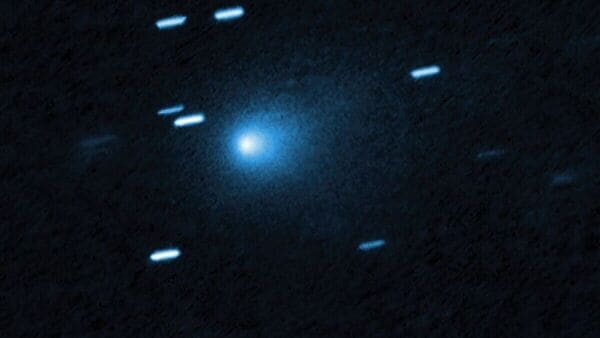Interstellar Comet 3I/ATLAS Reaches Closest Sun Approach
Key Takeaways:
- Comet 3I/ATLAS reaches perihelion on October 30, 2025
- Third confirmed interstellar visitor to our solar system
- No threat to Earth, closest approach in December 2025
- Multiple space agencies coordinating observation campaigns
The interstellar comet 3I/ATLAS is making its closest approach to the Sun on October 30, 2025, marking a significant astronomical event. NASA confirms this rare visitor from beyond our solar system will pass at about 1.4 astronomical units from the Sun.
Comet 3I/ATLAS Key Facts
This extraordinary celestial object presents unique characteristics:
- Speed: Traveling at approximately 210,000 km/h – the fastest recorded for a Solar System visitor
- Size: Estimated between a few hundred meters to several kilometers across
- Age: Believed to be billions of years old based on its interstellar journey
- Closest Mars Approach: ~30 million km on October 3, 2025
- Closest Earth Approach: ~270 million km on December 19, 2025
Current Position and Visibility
3I/ATLAS is currently passing through the constellation Virgo, located about 344.8 million kilometers from Earth. With a magnitude of 14.71, it remains too faint for naked-eye observation and requires advanced telescopes for viewing.
Due to its position almost directly opposite Earth on the far side of the Sun, scientists expect the comet won’t become visible from our planet until November.
International Observation Campaign
The European Space Agency (ESA) and NASA have mobilized extensive resources to study this rare interstellar visitor.
ESA astronomers began tracking immediately after its July 1, 2025 discovery by the ATLAS telescope in Chile. Observations now involve both ground-based telescopes and space observatories including Hubble and James Webb Space Telescopes.
ESA plans to utilize multiple deep-space spacecraft including Mars Express, ExoMars Trace Gas Orbiter, and the Jupiter Icy Moons Explorer (Juice) for additional data collection.
Scientific Significance
“Comet 3I/ATLAS offers scientists a rare opportunity to study material formed around a distant star system,” according to ESA. This marks only the third confirmed interstellar object observed, following 1I/’Oumuamua in 2017 and 2I/Borisov in 2019.
The comet’s hyperbolic trajectory confirms its interstellar origin, as it doesn’t orbit the Sun and will continue back into interstellar space.
Naming Convention
The designation “3I/ATLAS” follows international naming standards:
- “3” indicates the third confirmed interstellar object
- “I” stands for “interstellar”
- “ATLAS” credits the survey project that made the discovery
Safety Assurance
NASA emphasizes that 3I/ATLAS poses no danger to Earth, with its closest approach remaining at approximately 270 million kilometers – well beyond any risk distance.




